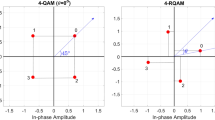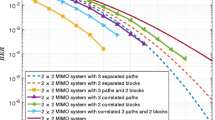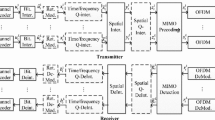Abstract
Coordinate interleaved orthogonal designs (CIOD) (Khan and Rajan in IEEE Trans Inform Theory 52(5):2062–2091, 2006) can offer desirable properties, such as full rate, full diversity and single-symbol maximum likelihood decoding for two, three and four transmit antennas under quasi-static fading channels. When fading is time-selective, zero-forcing decoder can applied to achieve good performance while still maintain low decoding complexity. In this paper, theoretical analysis of symbol error rate performance for CIOD codes over time-selective fading channels with a zero-forcing linear receiver is derived. Firstly, a closed-form expression (i.e., not in integral form) is derived for the average symbol pair-wise error probability (SPEP) in time-selective frequency-nonselective independent identically distributed (i.i.d.) Rayleigh fading channels. Then, the SPEP is used to derive a tight upper bound (UB) for the symbol-error rate (SER) of CIOD codes. Simulation results indicate that our theoretical UB often coincides (within 0.05 dB) with the true SER obtained via Monte-Carlo simulation. The UB can thus be used to accurately predict and optimize the performance of CIOD codes over time-selective fading channels.


Similar content being viewed by others
References
Tarokh, V., Seshadri, N., & Calderbank, A. R. (1998). Space-time codes for high data rate wireless communication: Performance criterion and code construction. IEEE Transactions on Information Theory, 44(2), 744–765.
Alamouti, S. M. (1998). A simple transmit diversity technique for wireless communications. IEEE Journal of Selected Areas in Communications, 16(8), 1451–1458.
Tarokh, V., Jafarkhani, H., & Calderbank, A. R. (1999). Space-time block codes from orthogonal designs. IEEE Transactions on Information Theory, 45(5), 1456–1467.
Jafarkhani, H. (2001). A quasi-orthogonal space-time block code. IEEE Transactions on Communications, 49(1), 1–4.
Tirkkonen, O., Boariu, A., & Hottinen, A. (2000). Minimal non-orthogonality rate 1 space-time block code for 3+ Tx antennas. In Proceedings of IEEE International Symposium on Spread-Spectrum Techniques and Applications (ISSSTA’00), (pp. 429–432). New Jersey, USA.
Papadias, C. B., & Foschini, G. J. (2003). Capacity-approaching space-time codes for systems employing four transmitter antennas. IEEE Transactions on Information Theory, 49(3), 726–732.
Sharma, N., & Papadias, C. B. (2003). Improved quasi-orthogonal codes through constellation rotation. IEEE Transactions on Communications, 51(3), 332–335.
Su, W., & Xia, X.-G. (2004). Signal constellations for quasi-orthogonal space-time block codes with full diversity. IEEE Transactions on Information Theory, 50(10), 2331–2347.
Khan, M.Z.A., & Rajan, B.S. (2002). Space-time block codes from co-ordinate interleaved orthogonal designs. In Proceedings of the IEEE International Symposium on Information (ISIT), Switzerland: Lausanne.
Khan, Z. A., & Rajan, B. S. (2006). Single-symbol maximum likelihood decodable linear STBCs. IEEE Transactions on Information Theory, 52(5), 2062–2091.
Đào, D. N., & Tellambura, C. (2008). Decoding, performance analysis, and optimal signal designs for coordinate interleaved orthogonal designs. IEEE Transactions on Wireless Communications, 7(1), 48–53.
Lee, H. J., Andrews, J. G., Heath, R. W., & Powers, E. J. (2009). The performance of space–time block codes from coordinate interleaved orthogonal designs over Nakagami-\(m\) Fading channels. IEEE Transactions on Wireless Communications, 57(3), 653–664.
Lee, Hoojin, Andrews, Jeffrey G., & Edward, J. (2008). Powers: Full-rate STBCs from coordinate interleaved orthogonal designs in time-selective fading channels. IEICE Transactions, 91–B(4), 1185–1189.
Jakes, W. C. (1974). Microwave mobile communication. New Jersey: Wiley.
Tran, T. A., & Sesay, A. B. (2004). A generalized simplified ML decoder of orthogonal space–time block code for wireless communications over time-selective fading channels. IEEE Transactions on Wireless Communications, 3(3), 855–864.
Vielmon, A., Li, Y(. G)., & Barry, J. R. (2004). Performance of Alamouti transmit diversity over time-varying Rayleigh-Fading channels. IEEE Transactions on Wireless Communications, 3(5), 1369–1373.
Gradshteyn, I. S., & Ryzhik, I. M. (2007). Table of integrals, series, and products. Massachusetts: Academic Press.
http://functions.wolfram.com/HypergeometricFunctions/Hypergeometric1F1/03/01/02/0011. Accessed May (2013)
http://functions.wolfram.com/HypergeometricFunctions/LaguerreL3General/06/01/03/01/02/0001. Accessed May (2013)
Author information
Authors and Affiliations
Corresponding author
Appendix
Appendix
To proof Theorem 1, we firstly introduce Lemma 1 as follow:
Lemma 1
Let \(X_1 =\frac{\left| {g_1 } \right| ^{2}}{\lambda _1 }\frac{SNR}{4}\Delta _{I}^2 =\frac{\left| {g_1 } \right| ^{2}}{\lambda _1 }c_{I} \) and \(X_2 =\frac{\left| {g_2 } \right| ^{2}}{\lambda _3 }\frac{SNR}{4}\Delta _Q^2 =\frac{\left| {g_2 } \right| ^{2}}{\lambda _3 }c_Q \) then \(X_{1}\) and \(X_{2}\) are independent random variables whose probability density functions (PDFs) respectively are
Proof
The proof of Eqs. (29) and (30) is the same, so we consider the proof of Eq. (29). Let us introduce the random variables \(\xi _{1k}\) and \(\xi _{2k}, \,k = 1,..., N_{R}\)
where we assume \(\rho ^{2} < 1\). By construction, \(\xi _{1k}\) and \(\xi _{2k}\) are independent and identically distributed with the same pdf as \(h_{1k}\)(2) and \(h_{2k}\)(1); furthermore, \(\xi _{1k}\) is independent of \(h_{1k}\)(2), \(\xi _{1k}\) and is independent of \(h_{2k}\)(1). Plugging (31) into \(X_{1}\) leads to
To simplify this expression further, observe that the fraction in (32) can be expressed as an inner product
where \(z_{1}, \,z_{2}\) are real variables, \({\mathbf {h}}=\left[ {h_{11} (2),h_{21}^{*} (1),\ldots ,h_{1N_{R}} (2),h_{2N_{R}}^{*} (1)} \right] ^{\mathrm{T}}\) and \({\mathbf {e}}=\left[ {\xi _{11}^{*} ,\xi _{21} ,\ldots ,\xi _{1N_{R}}^{*} ,\xi _{2N_{R}}} \right] ^{\mathrm{T}}\). Since e is symmetric, the distribution of \(z_{1}\) + j\(z_{2}\) reduces to the distribution of \(h_{1k}\)(1), independent of h (and, thus, also independent of \(\left\| {\mathbf {h}} \right\| )\). Thus, (33) simplifies to
where \(A=\sqrt{\lambda _1 \rho ^{2}c_{I}}\) and \(Z_i =\sqrt{\left( {1-\rho ^{2}} \right) c_{I}}z_i , \,i = 1, 2\). Therefore, given \(A, \,X_{1}\) has a noncentral chi-square distribution with two degrees of freedom, and PDF
where \(J_{0}(\cdot )\) is the zeroth-order Bessel function of the first kind, and \(\hbox {j}=\sqrt{-1}\).
However, \(A=\sqrt{\lambda _1 \rho ^{2}c_{I}}\) is Rayleigh distributed with 2\(N_{R}\) degrees of freedom with PDF
Integrating the product of (36) and (37) over the variable from 0 to \(\infty \) leads to the following PDF for \(x\) as
From (40), by using [17, equation(6.631.1)] we obtain
where \(_1 F_1 \left( {\alpha ,\beta ;z} \right) \) is Kummer confluent hypergeometric function [17]. By applying equations given in [18, 19] we have
Plugging (41) into (40) we obtain
The proof of Eq. (30) is similar. The Lemma 1 is demonstrated completely.
Remark 1
It is very interesting that although the calculation process from (31) to (42) is performed under the assumption \(\rho ^{2} <\) 1, the final result (42) is general and can apply to any value of \(\rho \) (which includes \(\rho ^{2} = 1\)). The proof of this observation is not difficult, so it is omitted here for brevity.
Next, we use Lemma 1 to demonstrate Theorem 1. Since \(X_{1}, \,X_{2}\) are independent random variables, thus the PDF of \(\omega \), which \(\omega =X_{1}+X_{2}\), is expressed by
Plugging Eqs. (29) and (30) into Eq. (43), we obtain
where \(\left( {{\begin{array}{l} n \\ a \\ \end{array}}} \right) {\triangleq } \frac{n!}{a!\left( {n-a} \right) !}, \,a_1 =\left( {{\begin{array}{l} {2N_{R} -1} \\ {2N_{R} -1-k_1 } \\ \end{array}}} \right) , \,a_2 =\left( {{\begin{array}{l} {2N_{R} -1} \\ {2N_{R} -1-k_2 } \\ \end{array}}} \right) \), and \(\mu =\frac{1}{c_{I}}\) \(-\frac{1}{c_Q }\).
By applying Newton’s binomial
we obtain
Then, using Eq. [17, equation (3.351.1)],
we obtain
The Theorem 1 is demonstrated completely.
Rights and permissions
About this article
Cite this article
Pham, VB. Performance Analysis of Full-Rate Coordinate Interleaved Orthogonal Designs Over Time-Selective Fading Channels. Wireless Pers Commun 82, 1733–1747 (2015). https://doi.org/10.1007/s11277-015-2309-2
Published:
Issue Date:
DOI: https://doi.org/10.1007/s11277-015-2309-2




